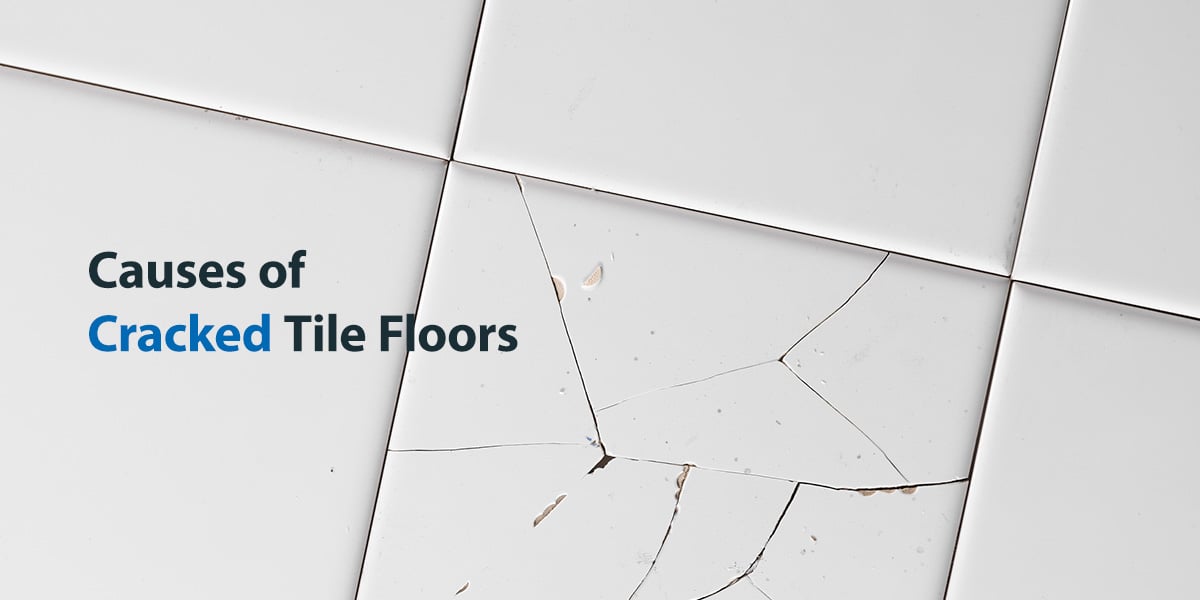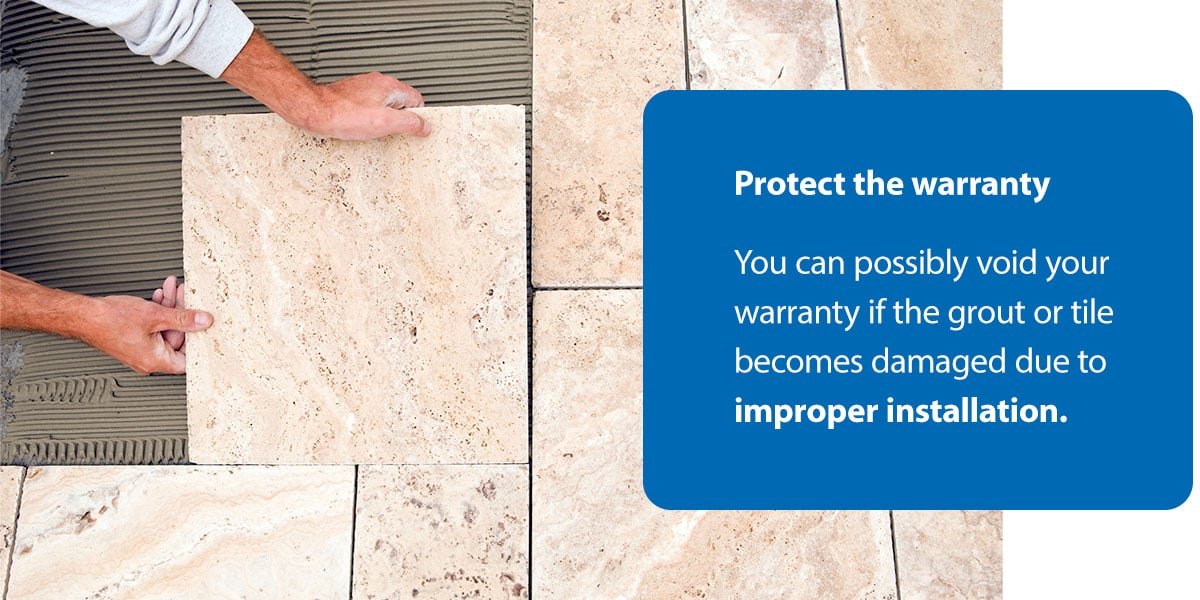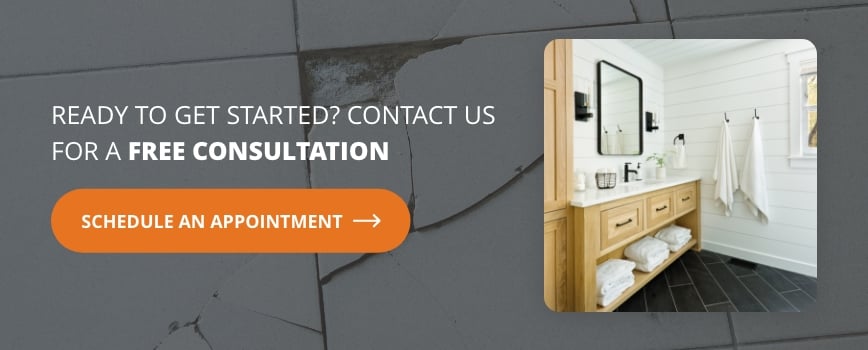

If you’re looking down at your tile flooring and see cracks, your first thought is probably, “How did this happen?” When you discover a broken tile floor, you want to know what caused it so you can protect your replacement floor from the same fate. For example, if there’s an issue with your home’s subfloor, you’ll want to address it before you retile your floor.
If the damage is limited to one area, all it needs is a cracked floor tile repair. In other cases, the best solution is to start with a clean slate and a new floor adequately installed by professionals. Learn the causes of tile flooring cracking and how you can protect it.
6 Common Causes for Cracked Tile Flooring


To help you find your cracked tile’s root cause, we’ve put together a list of the six most common causes of a cracked floor tile.
1. Control Joints in the Concrete Subfloor
All concrete inevitably cracks. When contractors pour the concrete for a subfloor, they intentionally weaken some areas to control where the cracks appear. Control joints allow a concrete subfloor to crack in an even, straight line, minimizing damage. Contractors and floor installers know better than to place tiles over a control joint since the concrete’s planned cracks would cause the tiles to break prematurely. However, an unsuspecting installer might place tiles directly over the control joints.
You can identify a tile crack related to subfloor issues if the fracture spans multiple tiles. If a relatively straight crack surfaces over the length of your floor, a control joint is likely the cause.
2. Heavy Impacts
Heavy impacts, such as dropping a dense object, can cause tile floor cracking. If a sharp blow is the culprit, the damage might appear more like a chip. Kitchen tiles are especially at risk because pots, pans, glassware and other heavy items are commonplace. Whether an item is precariously balanced on the edge of a countertop or slips due to some cooking grease, it can leave a chip in your tile.
In general, these types of impacts affect the edges of your floor, not the center. They’re also more likely to appear near cabinets or doors, as people often drop heavy objects while opening doors.
3. Heavy Furniture or Appliances
Quality tiles can withstand heavy loads. Most tiles can hold at least 250 pounds per square inch, depending on the construction. If your ceramic tiles meet the American Society for Testing and Materials (ASTM) C648-20 standard for breaking strength testing, they must carry at least this much weight without breaking. Does that mean that any appliance over 250 pounds can ruin your tiles? Not exactly.
Let’s say you have a refrigerator that weighs 400 pounds. If it has four legs, it will distribute its weight evenly onto four separate tiles. In this case, each tile would hold only 100 pounds — far from its breaking point. Based on this math, a four-legged appliance must weigh over 1,000 pounds before it puts enough stress on a single tile to cause any damage.
Considering the average full-sized refrigerator weighs roughly 170 pounds to 300 pounds, this isn’t usually a concern. Even a fully-stocked fridge with heavy pots of soup and a full-sized turkey inside wouldn’t come close to causing damage.
Stationary appliances rarely crack tiles. The problem comes when attempting to move them. Letting a heavy oven or even a cabinet fall would create a sharp blow concentrated on one area of the tile. So, furniture and appliances are most likely to cause damage during a move or right after a new tile floor is installed. Make sure you trust the moving company or flooring installer since their team will be responsible for safely moving your appliances and furniture.


4. Environmental Factors
While ceramic can tolerate fluctuating temperatures, tiles are porous materials. The more porous the tile, the more moisture it can hold, and the more it will be affected by rapid changes in temperature and moisture levels. Just as glass cracks under extreme temperature changes, so can terracotta, ceramic and porcelain.
Tile floors with properly spaced expansion joints give each tile plenty of space to expand and contract. Seasonal temperature and humidity changes won’t affect a sound installation.
5. Improperly Spaced Joists
If your tiles are placed over a plywood subfloor, your cracks might be related to the joists. Placing tile over plywood is challenging because wood has natural give and flex, while tile is rigid. When adhering these two materials to one another, the wooden beams running under the subfloor, the joists, become crucial.
These beams hold up the subfloor, the tile, the mortar and any furniture and people above. When the posts are too far apart, the wooden subfloor can bow. The tile, attached with mortar, is forced to bend along with it, which creates a crack. If your house is up to code, you shouldn’t be facing improperly spaced joists. If this is your root cause, it’s best to fix your subfloor before attempting to replace the tile.
6. Defective Tiles or Poor Quality Installation
Most tile cracking issues are prevented in a house that’s built to code by a trustworthy builder. If you’re experiencing cracks that aren’t related to heavy impacts or extreme dead weight, the problem could be the tiles themselves or the installer. If the previous homeowner or a contractor picked out the tiles, it’s possible they cut some corners. Always check your tile’s specifications and ensure they meet the American National Standards Institute (ANSI) and ASTM testing standards.
An unqualified contractor could also be to blame for any of the following:
- Not waiting 28 days for concrete to cure before installing tile can cause cracking from excess moisture.
- Not bonding the tiles properly can also damage them.
- Adding too much adhesive to the corners could create fractures in the ceramic as the glue dries.
- Using a non-waterproof adhesive for bathrooms or near swimming pools will cause tiles to break or crumble over time.
With the countless mistakes possible during tile installation, it’s critical to work with an experienced professional who can plan out the project from the start. Contact 50Floor to learn more about our extensive experience installing tile floors in homes like yours.
Flooring and Carpet Installation
Best Ways to Prevent Your Tile Floor From Cracking
If you have just installed a new tile floor, proper floor care and maintenance is the best way to prevent cracking. Regularly cleaning and removing mold from the tile and grout can prevent fractures and stop the tiles from coming loose. Sealing the grout after installation can prevent it from absorbing moisture, which will mitigate expansion and contraction. It’s also important to keep an eye on the tiles. If the grout becomes cracked, have it fixed promptly. If you spot a loose tile or an isolated crack, have the affected tiles replaced.
Quickly restoring your floor after damage prevents fractures from spreading. If you’re planning on replacing a broken tile floor or installing tile for the first time, you have more options. Before you install a tile floor, take these precautions to ensure a long-lasting installation:
1. Inspect the Subfloor
Your home should be up to code before installing new tiles, so ensure the house is inspected correctly to avoid tiles cracking.
Make sure you and your installer are aware of your subfloor’s current conditions. Have a professional check that the joists are correctly spaced and locate the control joints.
If you notice cracks in already-installed tiles and the problem is improperly spaced joists, your best bet is to remove the tiles altogether to fix the base.
2. Work With a Reputable Installer
Laying tile is one of the more challenging jobs to tackle. Even some professional contractors could leave you with shoddy handiwork. Make sure you work with flooring professionals who specialize in tile installation, like the team at 50Floor.
We do everything by the book, leaving you with stunning results. We use only the best materials, ensuring our tiles comply with ANSI testing standards for strength and durability.
3. Prepare the Subfloor
An even, level subfloor provides the foundation for a quality installation. Work with a flooring professional to discuss the best way to level your subfloor, whether it’s with a leveler or plywood. Next, clean your subfloor. Vacuum, mop and scrub to remove all the debris that may get under your tiles and form cracks.
4. Use an Anti-Fracture Membrane
Laying an anti-fracture membrane between the subfloor and the tile will protect your tiles from future damage. The membrane absorbs shock and disperses it throughout the floor so no one tile will bear the brunt of a sudden impact. Your installer might use isolation, uncoupling membranes, liquid-applied coatings or synthetic fabrics.
Anti-fracture membrane sheets are an excellent choice for wood subfloors because they allow separation between the subfloor without using a backer board, making title cracking even less likely. Additionally, uncoupling membranes are comprised of a waffle structure that provides space for moisture and humidity to escape before they can affect the subfloor.
5. Properly Maintain and Care for Your Tile
After your tile has been installed by a professional, properly cleaning and maintaining it can extend its life span and prevent cracks. You might employ professional grout and tile cleaning to remove mold, fix cracks and restore the broken tile to ensure it lasts longer. Having the grout sealed professionally can protect the pores.
What to Do if Your Tile Floor Is Cracked
When you have a tile floor cracking, it affects the appearance of an otherwise beautiful home. The best course of action in these cases is to contact professionals.
At 50Floor, we can help you replace your flooring using the proper methods. Working with an expert team ensures a job well done, preventing cracks from forming in the future and saving you time and money down the road.


Some key benefits of hiring professional tile installation include:
- Prevent damage: Trying to replace your tile on your own can lead to damage and expensive repairs or replacements. Professionals will ensure your tile is installed correctly, preventing water from seeping through cracks, stopping mold growth and helping you avoid tiles cracking on the floor.
- Protect the warranty: When you attempt a home project, you risk forfeiting your tile’s warranty. You can possibly void your warranty if the grout or tile becomes damaged due to improper installation. Hiring professionals can ensure your warranty is protected and you’re covered if any issues occur.
- Faster installation: You might consider doing your own installation to save money. Hiring an expert team will save you the long hours and energy you’d spend if you attempted to do it on your own. Professionals have adequate knowledge and experience and can deal with unexpected challenges that may arise.
- Expertise and special equipment: Like any other home project, tile installation requires special tools to complete the job correctly. While you might be able to rent materials, this will increase your project’s overall cost. A professional has access to this equipment, saving you time and money while properly installing your tile to prevent cracks in the future.
Schedule an Appointment to Replace Your Cracked Tile Floors
If you’re stuck with a cracked floor, the best thing to do is start fresh. Make sure your replacement tiles are high quality and installed by a pro. 50Floor offers a wide selection of quality luxury vinyl tiles to choose from. We let you shop for flooring from the comfort of your home. See all your options in your own light and against your own furniture.
Once you’ve found something you love, our installers take the greatest care to prevent tile cracks. We’ll safely move the furniture, inspect your subfloor and install a shock-absorbing underlayment. When we’re done, we clean up the installation mess and move furniture back carefully to avoid damage. If you’re ready to get started, contact us to schedule your free consultation.







